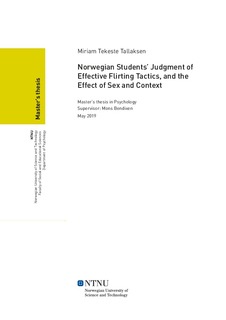Norwegian Students' Judgment of Effective Flirting Tactics, and the Effect of Sex and Context
Master thesis

View/
Date
2019Metadata
Show full item recordCollections
- Institutt for psykologi [3067]
Abstract
Flirting is a mate acquisition tactic, akin to self-promotion. Previous self-promotion studies have found clear gender and context effects in tactics judgment, but similar studies on flirting tactics have not been performed. Sexual strategy theory (SST) predicts these sex and context effects, but do not connect specific tactics to the various attractive mating cues (e.g. sexual availability). By applying a Sex of actor by Mating context (short-term and long-term) factorial design, the present study investigated the effect of sex and context on effectiveness judgment for twenty flirting tactics. Four hundred sixty-six Norwegian students completed one of four versions of an electronic survey, randomly assigned. Supporting the main hypothesis flirting tactics strongly associated with cues to sexual availability was judged as more effective for female actors in a short-term mating context. Flirting tactics not associated with cues to sexual availability had mixed results and are discussed in an SST framework. The effects of covariates (sex of rater, SOI, and extraversion) on tactic judgment were limited to certain flirting domains, and these effects was small or moderate. The present results suggest that the judgment of effective flirting tactics can be predicted by SST, and provides some conceptual implications on how the different tactics can be categorized and measured.